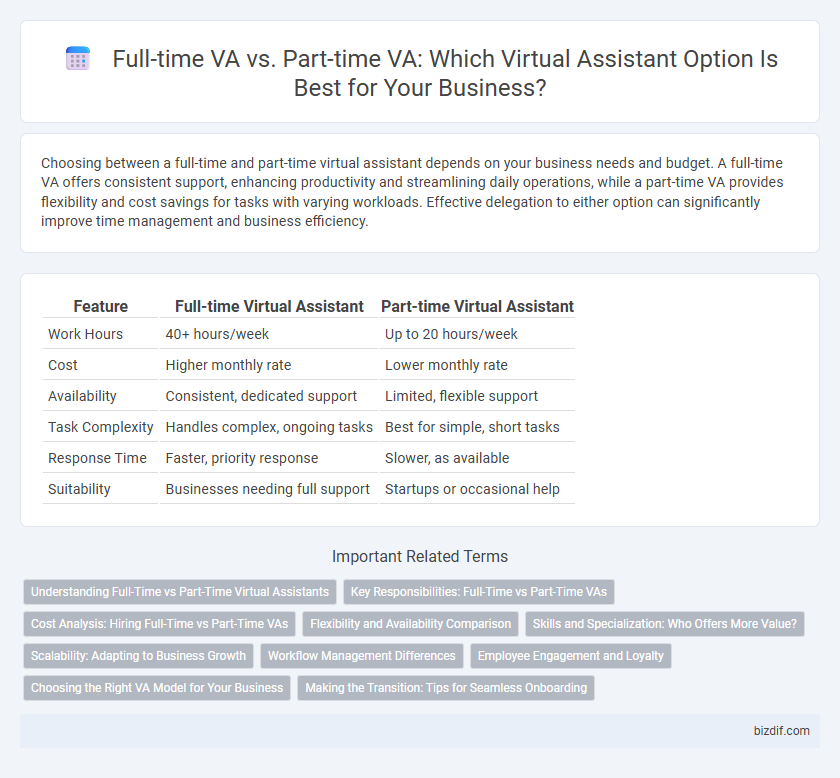Choosing between a full-time and part-time virtual assistant depends on your business needs and budget. A full-time VA offers consistent support, enhancing productivity and streamlining daily operations, while a part-time VA provides flexibility and cost savings for tasks with varying workloads. Effective delegation to either option can significantly improve time management and business efficiency.
Table of Comparison
| Feature | Full-time Virtual Assistant | Part-time Virtual Assistant |
|---|---|---|
| Work Hours | 40+ hours/week | Up to 20 hours/week |
| Cost | Higher monthly rate | Lower monthly rate |
| Availability | Consistent, dedicated support | Limited, flexible support |
| Task Complexity | Handles complex, ongoing tasks | Best for simple, short tasks |
| Response Time | Faster, priority response | Slower, as available |
| Suitability | Businesses needing full support | Startups or occasional help |
Understanding Full-Time vs Part-Time Virtual Assistants
Full-time virtual assistants typically work 40 hours per week, providing consistent availability and deeper integration into daily operations, which enhances productivity and alignment with business goals. Part-time virtual assistants offer flexible, task-based support for fewer hours, making them ideal for businesses needing occasional or specialized assistance without a full-time commitment. Evaluating workload, budget, and continuity needs helps determine the optimal balance between full-time and part-time virtual assistant engagement.
Key Responsibilities: Full-Time vs Part-Time VAs
Full-time virtual assistants handle a broader range of responsibilities such as managing emails, scheduling, customer support, and ongoing project management, providing consistent and dedicated support. Part-time VAs typically focus on specific tasks like social media management, data entry, or calendar organization, suited for businesses requiring flexible or task-specific assistance. The scope of work for full-time VAs often includes proactive problem-solving and strategic input, while part-time VAs deliver focused execution within limited hours.
Cost Analysis: Hiring Full-Time vs Part-Time VAs
Hiring a full-time virtual assistant (VA) entails a fixed monthly salary, often including benefits and overtime costs, making it a higher upfront investment compared to part-time VAs. Part-time VAs offer flexibility and lower expenses since payment is based on hours worked, avoiding extra costs during slow periods. Choosing between full-time and part-time depends on workload consistency, budget constraints, and the need for continuous support versus project-based tasks.
Flexibility and Availability Comparison
Full-time virtual assistants offer consistent availability and dedicated support, ensuring seamless handling of daily tasks and urgent needs. Part-time virtual assistants provide greater flexibility for fluctuating workloads, adapting easily to peak periods or specific projects without long-term commitment. Choosing between full-time and part-time virtual assistants depends on balancing continuous accessibility with budget-conscious, scalable support options.
Skills and Specialization: Who Offers More Value?
Full-time virtual assistants often provide a broader range of skills and deeper specialization within specific industries due to consistent engagement and continuous learning opportunities. Part-time virtual assistants may excel in niche areas or freelance expertise but might lack the comprehensive knowledge gained from ongoing projects and in-depth company immersion. Businesses seeking maximum value should evaluate the VA's skill diversity, industry-specific experience, and the ability to evolve with the company's needs over time.
Scalability: Adapting to Business Growth
Full-time virtual assistants provide consistent support, enabling seamless scalability as business demands increase, while part-time VAs offer flexible assistance ideal for fluctuating workloads. Hiring a full-time VA ensures dedicated availability, fostering rapid adaptation during growth phases, whereas part-time VAs allow cost-effective scaling without long-term commitment. Businesses prioritizing scalability often prefer full-time virtual assistants to maintain continuity and accelerate operational expansion.
Workflow Management Differences
Full-time virtual assistants provide consistent workflow management by maintaining continuous communication and handling tasks without interruption, ensuring seamless project progression. Part-time virtual assistants manage workload in segmented blocks, which may require more detailed handovers and scheduling adjustments to avoid workflow gaps. Efficient task delegation and clear priority setting are essential to optimize productivity based on the type of VA engagement.
Employee Engagement and Loyalty
Full-time virtual assistants (VAs) exhibit higher employee engagement and loyalty due to consistent daily interactions and deeper integration within the company culture. Part-time VAs often face challenges in building strong connections with team members, which can result in lower engagement levels. Organizations employing full-time VAs benefit from increased retention rates and a more committed workforce.
Choosing the Right VA Model for Your Business
Choosing the right VA model depends on your business needs, budget, and workload consistency. Full-time virtual assistants offer dedicated support and deeper integration with your operations, ideal for businesses with ongoing tasks. Part-time VAs provide flexibility and cost-efficiency for intermittent projects, making them suitable for startups or seasonal demands.
Making the Transition: Tips for Seamless Onboarding
Seamless onboarding for full-time virtual assistants involves structured training programs, clear task delegation, and consistent communication channels to ensure alignment with company goals. Part-time VAs require flexible scheduling, prioritized task lists, and regular check-ins to maintain productivity despite limited hours. Utilizing project management tools and setting measurable performance metrics facilitate smooth transitions and ongoing efficiency for both full-time and part-time virtual assistant roles.
Full-time VA vs Part-time VA Infographic

 bizdif.com
bizdif.com